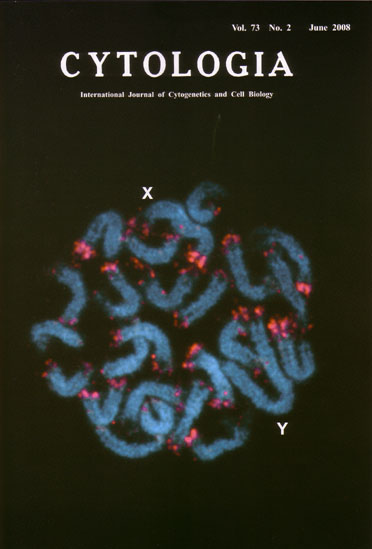| ON THE COVER |  |
|---|---|
| Vol. 73 No.2 June 2008 | |
| Technical note | |
|
|
|
| Detection of pseudo autosomal region in the Silene latifolia Y chromosome by FISH analysis of chromosomal distal end satellite DNAs.
Silene latifolia is a dioecious plant, which has 11 pairs of autosomes and heteromorphic X and Y sex chromosomes. These sex chromosomes can pair in meiosis only on a region of chromosome, pseudo autosomal region (PAR). PAR localization on the Y chromosome is able to be detected by FISH analysis by using the satellite DNA (satDNA) on the end of chromosomes as a probe in S. latifolia. The FISH image on male chromosomes of S. latifolia at early metaphase is shown on this cover. The probes were prepared by direct labeling with the Alexa Fluor dye 546. Chromosomal DNA was denatured at 75°C for 1 min in 2×SSC containing 70% formamide. The chromosome preparations were dehydrated immediately using 5 min treatments with 70% ethanol at -20°C and 100% ethanol at room temperature. The preparations were then treated with acetone for 30min at room temperature. Each slide was loaded with 8µl of hybridization mixture containing 1.25 ng/µl of satDNA (KpnI subfamily), 50% formamide, 10% dextran sulfate, and 2×SSC. The slides were washed at 42°C in 2×SSC containing 50% formamide, and then counterstained with DAPI. The fluorescent images were detected consecutively under a cytogenetic workstation equipped with a black and white CCD camera and processed with an imaging-software. In this aneuploidy line of S.latifolia, twenty five chromosomes including the X and Y chromosomes were observed irregularly. However, hybridization signals wewe detected on most of the autosomes, one arm of the Y chromosome, and both arms of the X chromosome. Since homologous recombination occurs in PARs, DNA sequences of PARs should be similar between X and Y chromosomes. Therefore, this result indicates that the PAR of the Y chromosome is located on the chromosomal end showing the hybridization signal. The extent of condensation varied between chromosomal ends in the early metaphase. The resulting hybridization signals were all located on the non-condensed ends of chromosomes. This result also indicates that the chromosome structure of the Y chromosome PAR is different from the other end of the Y chromosome. In this issue, Fujita et al. (pp. 159-165) report "An STS marker, Y202, located on the Silene latifolia Y chromosome between the chromosomal distal-end satDNA and SlY1". X, X chromosome. Y, Y chromosome. (Yusuke Kazama1 and Shigeyuki Kawano2, 1Radiation Biology Team, Nishina Center, RIKEN, 2-1 Hirosawa, Wako, Saitama 351-0198, Japan, 2Integrated Biosciences, Graduate School of Frontier Sciences, University of Tokyo, Bldg. FSB-601, 5- 1-5 Kashiwanoha, Kashiwa, Chiba, 277-8562, Japan) |
|